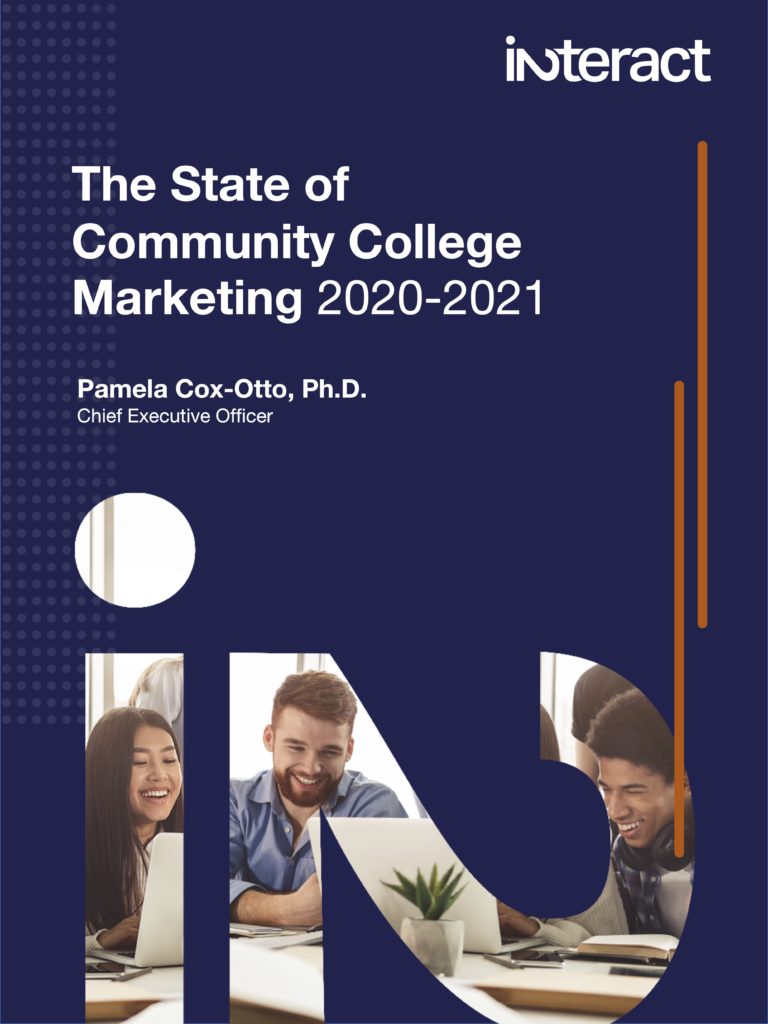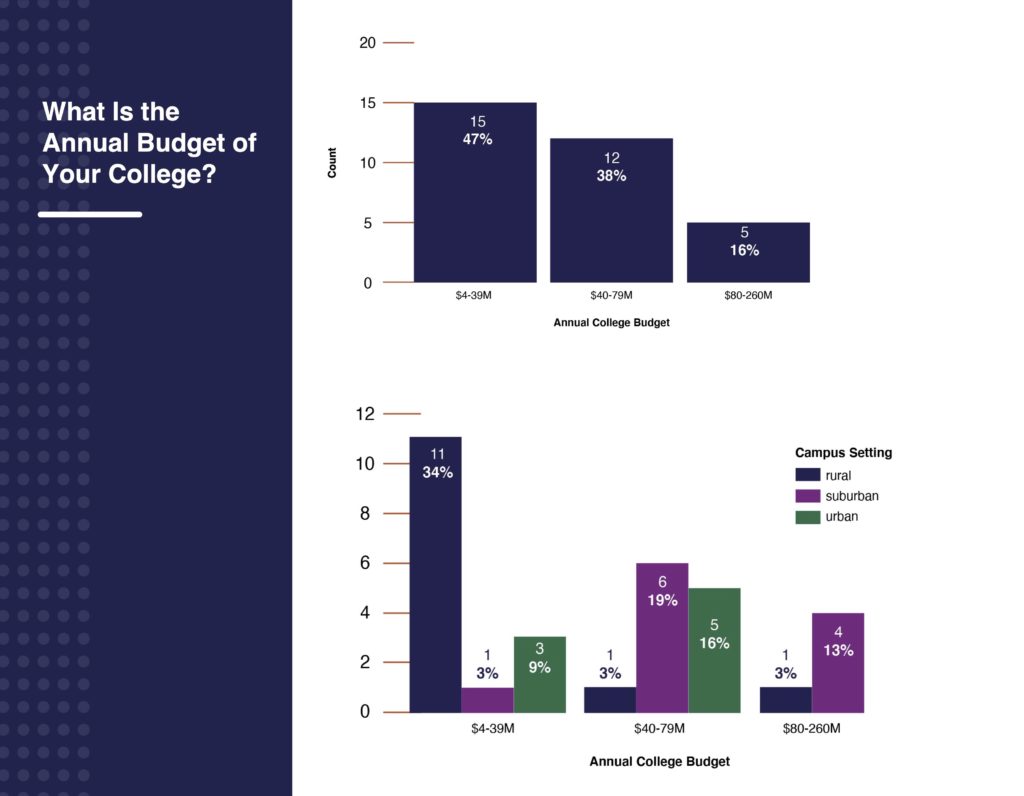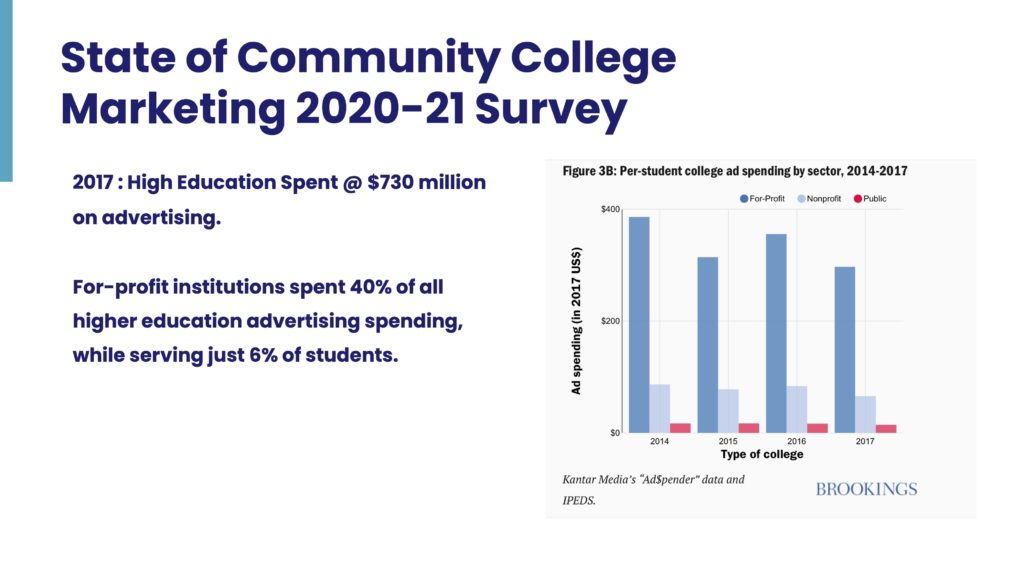Enrollment marketing is often the core of what we do as community college marketing professionals. Yet, there has been no nationwide data to compare how colleges market their programs, the size of their marketing budgets, or even how they use CRMs … until now!
Enter Interact Communications’ brand-new research survey that launched just last year, identifying a critical gap across 70+ community colleges.
“The State of Community College Marketing” report finally provides a national benchmark, making it possible to have the hard data you need to back up requests for more funding, staff, and support to bolster your enrollment marketing and communication efforts.

But before we get into the details of the eye-opening enrollment marketing gap and recommendations to help, let’s start at the beginning — the very beginning!
How the Enrollment Marketing Gap Originally Spurred Our CEO
“The entire time I worked at community colleges, I struggled to know when I was ‘doing the right thing,’” recalls Dr. Pamela Cox-Otto, our CEO and community college champion. “I was a rookie then. And whenever enrollment stumbled or didn’t grow, I was told it was my fault. Marketing needed to ‘kick it up a notch.’”
Cox-Otto “whipped her staff into a frenzy” to boost enrollment, and when applications went up nearly 50%, who received the accolades during convocation? The faculty, counselors, financial aid, and college planning … but not the marketing department.
“That was the moment when I realized that marketing is frequently made the whipping boy but seldom the hero for enrollment,” recalls Cox-Otto.
Yet, it was not becoming an unsung hero that bothered Cox-Otto, so much as a niggling question. Though applications had gone up 50%, why had they only netted an 8% increase in student enrollment? It’s because somewhere in the enrollment process, students had gotten lost.
“It’s gotten better over the years,” reflects Cox-Otto, “But many colleges still lose anywhere from 30 to 60+ percent of students between application and day one of classes. And that loss is catastrophic … That student may never come back.”
Empowering the whole enrollment process, from marketing to student services and beyond, inspired Cox-Otto to establish Interact Communications 25 years ago. And while Interact’s origin is a story for another time, last year, we hit a new milestone in helping community colleges. The team created a unique kind of research to uncover crucial data community college marketers need but never had before …
First National Community College Survey of Its Kind Uncovers Enrollment Marketing Gap
With the pandemic putting pressure on 2-year colleges and marketing departments like never before, Interact wanted to arm our partners with better, smarter data. Was there an innovative way for marketers to compare their community college to others regarding structure, resources, tools, staffing, and budget? You bet!
The team sent a comprehensive survey of 56 questions to 936 community college marketing professionals across the country in December 2020. Then, Interact’s research team spent multiple months reviewing the data and re-running results to dig below the surface.

In “The State of Community College Marketing 2020-2021” report, we discovered surprising insights into nationwide community college marketing efforts. Today, we’d like to share our major takeaway.
The #1 Enrollment Marketing Takeaway from 70+ Community Colleges
The single largest result from the report is this:
Community college marketing and outreach are vastly underfunded.
Most companies invest between 10 and 20% of their total budget in marketing, communications, and advertising.
At community colleges, that number is around one-third of 1%.

That’s right — across the board, less than 1% of community colleges’ total budget goes to marketing.
“Colleges seem eminently willing to invest in staff, but not in giving staff the resources to do their job effectively,” writes Cox-Otto in the report. “These low marketing investment rates in colleges are vestiges of the old educational attitude, ‘If you offer it, they will come.’”

And while Cox-Otto confides that there was a time when simply offering programs worked, it’s no longer effective. Why? Because the passive ways marketers used to provide info to their communities no longer reach audiences. As Cox-Otto writes, “It is critical that we push information to our community rather than expecting them to come find it.”
Yet effective marketing in today’s world takes money and resources … And as the report reveals, community colleges are often working on a shoestring budget.
Doing the Math: Annual Budgets Versus Marketing Budgets at 2-Year Colleges
Have you ever wondered how your annual and marketing budgets compare to other community colleges? We’re about to spill the beans!
Annual Budget Myths Debunked

Our survey discovered that most community college budgets — 47% of them, to be precise — range somewhere between $4 million and $39 million a year. At the higher end of funding, responding urban colleges reported budgets between $37 million and $260 million. However, the average urban college has an annual budget of $53,000,000.
These findings busted the myth that an urban environment automatically equals a larger budget. It definitely does not!
In fact, many urban colleges may be in a large city but only serve a small portion of that city. That means they have the cost of being an urban school, but they are in a much more competitive environment.
Marketing Budgets across the Country

The survey discovered that marketing department budgets for urban colleges range between $85,000 and $1.2 million. On the other hand, the average marketing budget for suburban schools came in at $604,000 annually, ranging from $100,000 to nearly $2 million.
Finally, rural colleges have an average annual budget of slightly more than $308,000 a year, ranging from $15,000 to more than $2 million. Talk about variation!
Most community colleges manage their marketing with small budgets. And yes, sometimes this is true even if they are in an expensive, urban environment.
“If you are a rural college performing fishes-and-loaves miracles with a tiny budget, be glad you are not a school operating in Los Angeles or Chicago or New York with that same tiny budget,” writes Cox-Otto. “That happens, people.”
Advertising Budgets: Keeping up with For-Profits
“Your local for-profit college typically spends 20% of their entire budget on marketing,” writes Cox-Otto in the report. “Yes, I know you’ll never get 20% of your community college’s budget. But you simply can’t compete against these marketing behemoths if the college is giving tiny amounts with which to work miracles.”
Drilling down into advertising budgets reveals even more variation across 2-year colleges. On average, urban schools spend anywhere from $25,000 to $500,000 on media annually.
On the other hand, suburban colleges have an average of $262,000 to buy media. However, our survey revealed a single college with only $5,000 in its budget for this purpose. Meanwhile, one-third of these colleges have less than $100,000 to spend.
Rural colleges have an average of $125,000 to spend annually on media, including digital and traditional marketing. Their budgets for this activity range from $35,000 to nearly half a million dollars.

“For me, the takeaway is clear,” writes Cox-Otto. “Those urban schools who responded to the survey are in the most expensive areas to live in the country. But even with their larger markets, most do not have more college resources than their colleagues from other markets.
“Their budgets are larger, but so are their staff costs. And when you simply look at the resources being brought to bear to place advertising, they honestly don’t have much more.”
How to Use Budget Data to Your Advantage for Enrollment Marketing and More
Marketing departments must understand their budget in relation to their college’s annual budget. Why?
“If you don’t know what percentage of the college budget you have, you’re unable to make a compelling argument to increase your percentage to increase your results,” writes Cox-Otto.
While the quality of your college and its instruction will always count, that quality will not make up for the lack of marketing dollars that allow you to spread that news.
Three Simple Ways to Boost Enrollment Marketing on Any Budget
The report offers a plethora of recommendations to move forward with the data to make smart decisions and advocate for your department. Below are just a few examples from the report:
1. Less Is More
At a community college, the amount of work will always exceed your staffing. So, how can you maximize your impact?
“The critical thing you need to do is identify those things that will actually move the needle and focus on them,” advises Cox-Otto. “More importantly, get buy-in from your leadership on those issues.”
That way, she says, your department won’t be pressured into doing too many small projects that scatter your time and money and do not impact your enrollment or other crucial areas.
2. Mind Your Toughest Audience
Internal constituents can make or break you, warns Cox-Otto. Your toughest audience will always be inside your college. That’s because, in many ways, marketers create the institution’s belief structure and impact the faculty’s self-image.
“Keep them [faculty and staff] informed the way you would tell your own family what you are doing and when,” recommends Cox-Otto. “They may not be happy, but they are much less likely to grab torches and storm your castle.”
3. Convert Applicants into Students
Most colleges lose between 30 and 70% of their applicants between the application and census day.
As the report advises, “If you could even keep an additional 10% of those students, you wouldn’t have an enrollment problem.”
The issue is that most 2-year colleges have data systems that track only year-over-year data but do not provide actionable information to help colleges fix the holes in their pipelines.
“This is something Interact and I have been spending a great deal of time on to come up with ongoing measures that can increase your conversion rates,” writes Cox-Otto. “When your budgets are small or being cut, it all comes down to efficacy. Make every single inquiry count.”
Even More Powerful Insights to Bolster Enrollment Marketing
Have you ever wondered …
- How are other community colleges organized, including salary and duties for marketing and communications?
- How many staff members do other marketing departments have?
- Do other colleges use a CRM (customer relationship management) system? If so, which one, and how satisfied are they with its performance for enrollment marketing and more?
- What other kinds of tools and software do other departments use?
- Do other departments have a seat on their college’s leadership committee, group, or team? Why or why not?
Interact’s “The State of Community College Marketing 2020-2021” report answers all these questions and so many more, alongside valuable insights and powerful recommendations. And we’re giving away this $1,000 value for free!
Keep reading to find out how to receive your copy …
Secure the Data to Bolster Your Enrollment Marketing and Beyond!
The 2020-2021 report comes from our first year crunching this kind of data, but it won’t be the last! The 2022 survey is now open, with enhanced features on the way.
We plan to segment the data to make it even easier for colleges to compare themselves with other 2-year schools across the country. Eventually, results will be available online, in an easy-to-use format similar to our Media Preferences report.
“Your college may think they’re giving you plenty of money, but when you compare it to others in similar environments — urban, rural, or suburban — you may be underfunded,” warns Cox-Otto.
That’s why we’re giving participants in this year’s survey exclusive access to our national data at no cost! You won’t find this information anywhere else, with hard facts you can use to build and shape your college’s marketing department.
For a Limited Time Only — Receive TWO Free Reports!
Take this year’s The State of Community College Marketing survey, and you’ll receive the 2021-2022 survey results as an eBook (a $1,000 value). Plus, you’ll also have the option to request the 2020–2021 edition (another $1,000 value) at no cost! That’s a $2,000 value for two years of practical marketing insights to boost your enrollment efforts and beyond.
According to Cox-Otto, this report is a labor of love to help our 2-year colleges thrive:
“It’s information that will help marketers, communications professionals, and college leadership understand what I didn’t understand when I had their jobs: how different or similar your college marketing is in structure, resources, tools, and staffing, as well as what is holding you back, and how you could do more or at least do it differently.”
Free Financial Aid Toolkit (A $5,000 Value) And Chance to WIN an iPad!
Because we know our community colleges are struggling with enrollment in the wake of the pandemic, we’d also like to offer another valuable gift to our survey participants. One of students’ biggest pain points is financial aid communications, which can make or break their enrollment.
That’s why we’re also giving participants a free financial aid toolkit (a $5,000 value!) that includes the following:
- 2 digital ad sets
- 2 social ad sets
- 1 flyer that doubles as a table tent
This one-and-done toolkit is easily customizable with your college’s branding and information, providing a streamlined way to promote your financial aid services, free tuition programs, and links to apply. We hope that giving away this toolkit can help give your enrollment marketing an extra push this season.
And, just for fun, all participants will be entered into a raffle to win an iPad! The winner will be announced live on social media in the first week of May.

We hope you’ll join us and snag your …
- two free “The State of Community College Marketing” reports
- free financial aid toolkit
- and a chance to win an iPad
by participating in this year’s survey!



